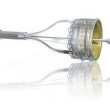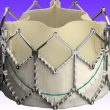A mean gradient ≥40 mmHg, an aortic valve area ≤1 cm², or a combination of both, during dobutamine stress echocardiography, correctly qualifies as severe aortic stenosis in about half of all patients. The other half consists in cases of pseudo-severe aortic stenosis. In turn, a projected aortic valve area ≤1 cm² is a much better indicator than the...
Reverse Myocardial Remodeling Following Valve Replacement
After aortic valve replacement, focal fibrosis does not resolve, but diffuse fibrosis and cell hypertrophy regress. As expected, this regression comes with structural and functional improvement that suggest it is a dynamic process. Fibrosis can be measured and quantified with cardiovascular MR, which makes it a potential therapeutic objective. Left ventricular hypertrophy is a key...
NOTION: 5-Year Outcomes of TAVR vs. Surgery in Low-Risk Patients are Promising
At 5 years, there were no differences in all-cause death, stroke, acute myocardial infarction, or all of these combined between low-risk, elderly patients who underwent transcatheter aortic valve replacement (TAVR) or conventional surgery. Taking into account reports from previous years, these results are not at all surprising. NOTION enrolled an all-comers population that was 70 years old...
Red Light for TAVR in Low Surgical Risk Patients
A new study raises an alarm against expanding transcatheter aortic valve replacement (TAVR) procedures to low surgical risk patients, since 2 year mortality seems higher in these patients with TAVR, compared to conventional surgery. This study will soon be published in Catheter Cardiovasc Interv. Expanding TAVR to low risk patients might involve risks we have not...
Leading Manufacturer of Balloon-Expandable Valves Launches Self-Expanding Device
Edwards Lifesciences could have been satisfied after the success of the PARTNER trials and the improvements to its balloon-expandable valve (mainly as regards the delivery system profile and paravalvular leak reduction) in its last model, SAPIEN 3. However, it was not. The company decided to keep going, developing a valve that is radically different from its...
Transcatheter Mitral Valve Replacement Devices Multiply
The Transcatheter mitral valve replacement has been established as gold standard for patients with intermediate or high risk severe aortic stenosis. The supporting evidence was initially gathered with one or two safe and effective devices that worked really well, so that later on prosthetic valves multiplied, for competing companies wanted their share of the market. However,...
WIN TAVI: The Largest Female TAVR Registry So Far
Courtesy of Dr. Carlos Fava. In most randomized or observational studies, women comprise more than 50% of patients undergoing TAVR, and they have showed better evolution, compared against surgery. The main differences between men and women with severe aortic stenosis are that women have smaller annular dimension, shorter distance to coronary ostia, smaller peripheral arteries, and...
Lotus Valve in Real Life Patients: the near total lack of leaks is its greatest strength
Even though the incidence of complications in transcatheter aortic valve replacement (TAVR) have significantly decreased, there is one in particular that remains a concern since, when mild, it is associated to increased events rate. This complication is prosthetic paravalvular leak , which happens between the native annulus and the stent. The Lotus valve, completely repositionable, uses a...
Failing Surgical Bioprosthesis: A Challenge on the Rise
Courtesy of Dr. Carlos Fava. The gold standard for failing aortic bioprosthesis has traditionally been surgery. However, since the first valve in valve (TAV-in-SAV) report in 2007, by Wenaweser, transcatheter valve implantation has emerged as a valid alternative. Even so, at present there is not enough scientific evidence in this regard. The present study analyzed...
Lung Disease and TAVR: Beneficial for a Reduced Group of Patients
Chronic Lung Disease often affects patients with severe aortic stenosis undergoing transcatheter aortic valve replacement (TAVR) or surgery. In fact, this is why patients with lung disease are often deemed inoperable and prescribed TAVR. This is the first time the benefit of TAVR has been assessed in this group of patients, for symptoms of these conditions can...









